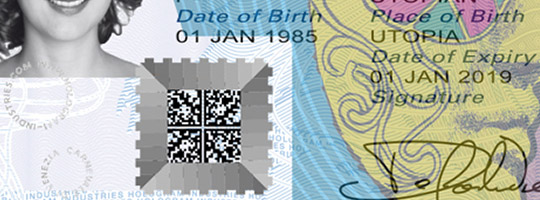
When photonics enter the e-ID challenge
Confidence is a cornerstone for our societies to enjoy the benefits of an open world and mitigate the risks posed by increased regional tensions and the spread of a dark economy. Identity authentication systems enable such confidence, and the e-ID challenge is to integrate them into the digital and mobility age, while caring for citizens’ concern about the security and privacy balance.
Photonics can contribute and deliver desired features of e-ID, and notably the protection of privacy, as exemplified by the OpticalSmartTM ID product family developed by SURYS.
At the convergence of optical and digital sciences, OpticalSmartTM provides ID document automatic authentication, proof of non-tampering, bearer proof of identity, traceability and control tracking functions. This is achieved by leveraging the ubiquity of the smartphone as a light source, high resolution camera, digital memory and a cloud connected computer, geolocalized.
The OpticalSmartTM ID Card integrates the latest photonics advances with carefully engineered micro and nanostructures. Some of these optically variable features are quick to verify, easy to understand and to communicate and overall robust against imitation, and can be verified by human eye observation and recognition. But others, engineered for machine vision, create an “optical chip” device, to be read by a camera and analyzed by a computer, as a secure key to access information.
The ID card is personalized and fingerprinted at an enrollment station deployed in an authorized place, to become uniquely referenced in the system common data base with its “document biometrics”.
A typical application of OpticalSmartTM ID system is the control of identity by an authorized person, say a police officer. Using a custom smartphone app allows the controller to check the ID card security features, through the verification of a high optical resolution picture integrated in the holographic patch applied on the surface of the card, and simultaneously a verification of a data matrix printed on the card next to this optical security feature.
The “optical chip” at the heart of OpticalSmartTM systems enables multiple functions, both off-line and when securely connected to the cloud through a smartphone, without additional hardware requirements like the today prevalent “electronic chip”. It also belongs to the Privacy-by-Design approach, that may soothe citizens’ concerns with “electronic chip” identification tags, as illustrated last October when the governor of California, Jerry Brown, decided under public pressure to veto a bill that would have seen an option for radio frequency identification tags offered to applicants for new driver’s licenses, perceived as threatening holders’ data privacy like a person’s race or citizenship status.
Expect photonics to be a key technology in the e-ID race !
Michel Mariton
